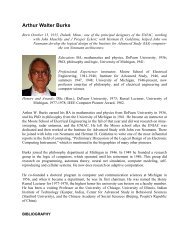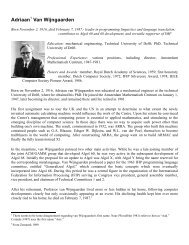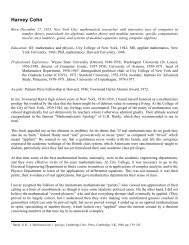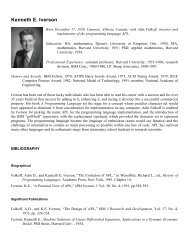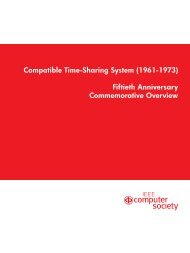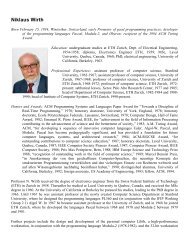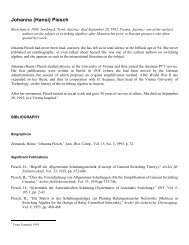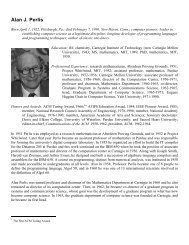John Grist Brainerd
John Grist Brainerd
John Grist Brainerd
- No tags were found...
You also want an ePaper? Increase the reach of your titles
YUMPU automatically turns print PDFs into web optimized ePapers that Google loves.
development projects the government ever invested in.” Some of this controversy has beenreported in Annals articles, most notably in “The ENIAC: First General Purpose ElectronicComputer,” by Arthur W. Burks and Alice R. Burks (Vol. 1, No. 4, October 1981), and “<strong>John</strong>Mauchly's Early Years,” by Kathleen R. Mauchly, (Vol. 6, No. 2, April 1984), and the associatedcomments, queries, and debates.When Eckert and Mauchly left the Moore School as a consequence of a disagreement aboutpatent rights, 1 <strong>Brainerd</strong> remained at the University of Pennsylvania. It appears that whereas theythought the patents should be theirs, <strong>Brainerd</strong> and others thought the benefits of the inventionsshould go to the University.<strong>Brainerd</strong> took no further part in later Moore School computer project work, but devoted himselfto graduate teaching, administration as director of the Moore School, and curriculum revision.His tenure as professor encompassed the transition of the electrical engineering field from a nearexclusiveemphasis on power, with a slight concern with telegraphy and telephony, to thevacuum tube era, and ended as the discipline actually developed into what is now calledcomputer science and engineering. <strong>Brainerd</strong> handled the first part of the transition well, and wasa leader in the introduction of the mathematics of electric and magnetic fields and thetransmission of energy and information into the teaching of electrical engineering. Although heparticipated in the earliest development of computers (especially in regard to his specialty,electronic circuits), like some leading classical physicists who never really accepted quantumelectrodynamics, he never became a full participant in the new world of computing. He alwaysadmitted its worth but he never felt that he understood the field sufficiently to contribute to it.In the early days of computers, <strong>Brainerd</strong>'s idea of the proper way to employ them was to set themto solving differential equations and publish the results in the form of highly precise tables offunctions. Engineers could then use these new tables much as they did tables of BesselFunctions. At that time he did not see the possibility of solving problems directly, or conceive ofthe computer age.Several generations of students learned the basic principles of electrical engineering and itsrelated mathematics as a consequence of Dr. <strong>Brainerd</strong>'s long and useful career as a teacher,textbook author, and hands-on department administrator. Although in public he may havepresented a quiet and reserved personality, and to his students sometimes seemed overly rigorousand demanding, his friends and professional associates appreciated his sharp mind and enjoyedhis quiet but quick sense of humor. 2 33BIBLIOGRAPHY1See the biographies of J. Presper Eckert and <strong>John</strong> Mauchly.2From, Weiss, 1988,
BiographicalBurks, Arthur W., and Alice R., “The ENIAC: First General Purpose Electronic Computer,” Ann.Hist. Comp., Vol. 3, No. 4, 1981, pp. 310-399.Fegley, Kenneth A., and S. Ried Warren, “Eloge: <strong>John</strong> <strong>Grist</strong> <strong>Brainerd</strong>,” Ann. Hist. Comp., Vol.10, No. 4, 1989, pp. 361-365.Weiss, E.A., “<strong>John</strong> <strong>Grist</strong> <strong>Brainerd</strong>: Obituary,” Ann. Hist. Comp., Vol. 10, No. 1, 1988, pp. 78-79.Significant Publications<strong>Brainerd</strong>, J. G., and T.K. Sharpless, “The ENIAC,” Electrical Engineering, Vol. 67, No. 2, Feb.1948, pp. 163-172.<strong>Brainerd</strong>, J. G., “Genesis of the ENIAC,” Technology and Culture, Vol. 17, No. 3, July 1976, pp.482-488.Eckert J. Presper Jr., <strong>John</strong> W. Mauchly, Herman H. Goldstine, J.G. <strong>Brainerd</strong>, Description of theENIAC and Comments on Electronic Digital Computing Machinery, ContractW/670/ORD 4926, Moore School of Electrical Engineering, Univ. of Penn., Philadelphia,Nov. 30,1945.UPDATESPortrait inserted, MRW, 2012.






